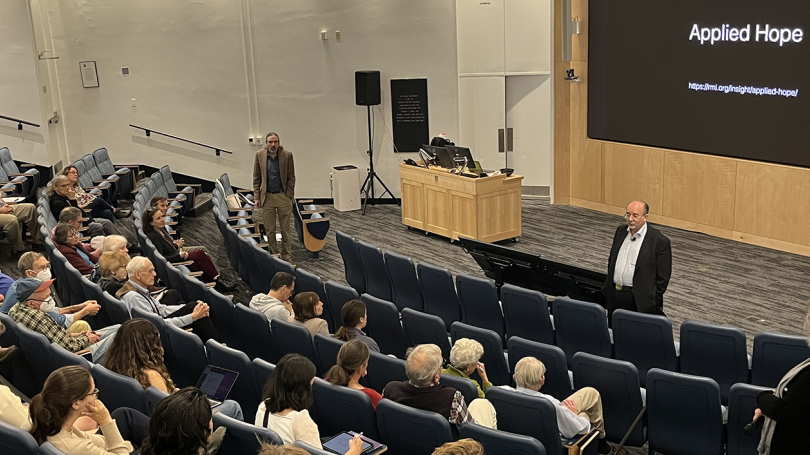
- About
- Education
- Research
- Engagement & Collaboration
- News & Events
Back to Top Nav
Back to Top Nav
Back to Top Nav
Back to Top Nav
Why "applied hope"? You cannot depress people into action, says energy efficiency guru Amory Lovins.
"Saved energy is the world's biggest energy source today."
On a warm October Saturday, Rocky Mountain Institute (RMI) cofounder Amory Lovins gave a talk both pragmatic and visionary to an audience of Dartmouth students and Upper Valley residents. The talk, titled "Radical Energy Efficiency, Integrative Design, and Applied Hope" was co-sponsored by the Irving Institute and Dartmouth's Office of Sustainability.
Lovins and RMI have made a global mark by transforming how energy is used – and how energy use is avoided – in industries, businesses, facilities, and communities across the planet. According to the Intergovernmental Panel on Climate Change, efficiency can deliver 40 to 70% of future decarbonization. In Lovins' view, this drastically underestimates the full potential of energy efficiency to reduce energy use and its social, environmental, and financial costs because it focuses primarily on "upstream" efficiencies: those gained by making electricity more efficiently or substituting more efficient renewable energy generation for fossil fuels.
Lovins' focus was on "downstream" efficiencies: those gained via "higher efficiency in the equipment being powered, or the building being heated, or the vehicle being moved." He characterizes "energy efficiency resources [as] an infinitely expandable assemblage of ideas," drawing upon ingenuity as much as engineering. Ultimately, his case for "radical energy efficiency" captures both of these forms, as he argues that "the conversion efficiencies upstream and the end use efficiency downstream multiply and together they form a primary energy efficiency, and by that crude metric, saved energy is the world's biggest energy source today."
Inglorious, but Deeply Impactful
And its future promise is even greater. Energy intensity – the amount of energy used to produce a unit of gross domestic product – has dropped 61% in 47 years (Lovins' mid-1970's prediction that it could drop 72% in 50 years may not be far off) and, he predicts, will drop by another third or more by 2050. To achieve that potential, Lovins argues for widespread teaching and adoption of "integrative design."
Too much engineering design is disjointed, in his view, seeking to optimize individual parts or subsystems, rather than approaching a challenge holistically. In contrast, integrative design starts with a sharp focus on tightly defining the desired energy service, optimizing a whole systems rather than "pile of disparate components" approach, and can then "pay for" efficiency measures through the reduced cost of smaller core systems. Lovins, noting that Dartmouth's engineering curriculum is particularly well-suited to foster an integrative approach to design, then described the inglorious but deeply impactful example of how piping systems are designed.
Pipes and pumps are a building's circulatory system, moving steam and water around to heat and cool space and manage flows of potable water and effluent. Pipes are often narrow and configured to bend around other building systems – yet the fluids within them flow most efficiently when pipes are wide in diameter and straight, or at least minimally curved. Pumping systems may account for as much as 20% of global electricity use. Integrative design calls for "fat pipes and small pumps," and can result in more than 80% energy savings when compared to typical design.
Cultivating a Different Kind of World Through "Applied Hope"
Lovins argued that radical energy efficiency, achieved through integrative design, can drastically reduce energy use and serve as a major lever to reduce carbon emissions and improve our climate futures. But achieving this compelling vision is no small feat, and Lovins acknowledged that there is much cause for concern and uncertainty about our planet's climate future.
The remedy he offers is not blind optimism, but rather applied hope: a "pragmatic and grounded conviction that starting with hope and acting out of hope can cultivate a different kind of world." Unlocking human creativity, fearlessness, and an enduring commitment to the "child's mind" that sees old problems with fresh eyes can — and in Lovins' view must — undergird our approach toward creating a better world. Falling short of that call "condemns our descendants to perpetual retrofit of inefficient stuff – not a worthy legacy."
In Lovins' view, "the energy transformation now underway [is] the biggest technology shift since the invention of agriculture." To equip ourselves for and accelerate that transformation, individually and collectively, Lovins calls for us to recognize that "hope is a stance, not an assessment." In that stance, together, we can unlock the vast potential of energy efficiency and "[support] a thriving world with less energy than today, where resilient, right-sized energy systems make major failures impossible, not inevitable."
You can view a recording of Amory Lovins' October 28th talk, "Radical Energy Efficiency, Integrative Design, and Applied Hope," here.